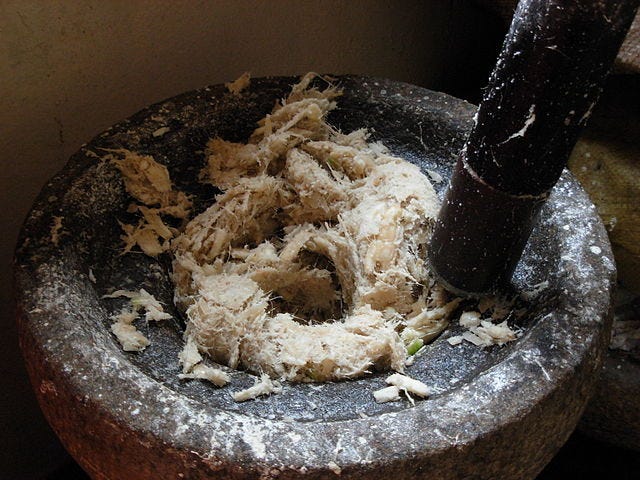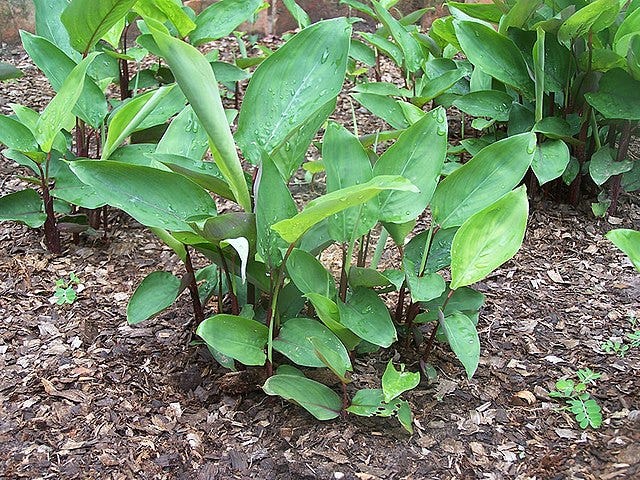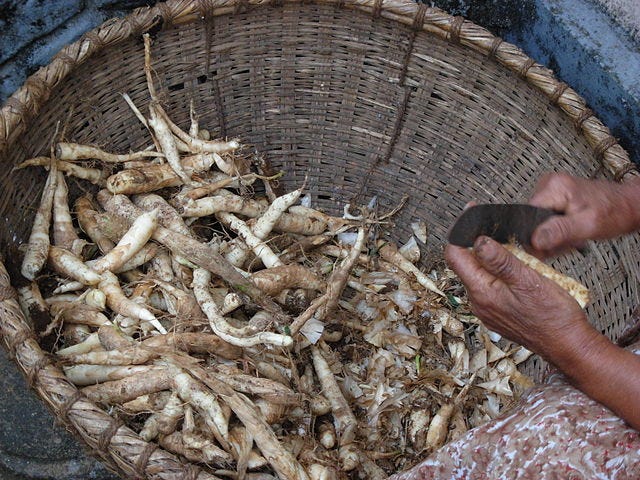A few weeks ago I was in the mood for some curry so I made a short trip to an Indian grocery store a couple of subway stops away from my apartment. I was looking for some particular things but I picked up a bag of sago pearls on a whim, thinking I’d make some pudding. At the time, I thought that sago and sagú were similar names for the same plant, just a matter of language. But, as it turns out, I was wrong. The confusion is understandable because these names are often used interchangeably. But, in fact, sago and sagú are entirely different plants that happen to have products with similar properties and effects. They are both starches that are eaten and have thickening properties. This is likely the root, pun intended, as you’ll see below, of the confusion. To complicate matters more, sago pearls are often mistaken for tapioca pearls, which are the delicious, chewy bubbles at the bottom of your bobba (or bubble) tea among other things. And tapioca is sometimes mistaken for sago and sagú.
Sago comes from Asia, from the pith of various palm trees, collectively known as sago palms. There is, however, a palm that is considered the true sago palm. Its scientific name is metroxylon sagu and it is native to southeastern Asia. Nevertheless, the cultivation of sago palms has extended to other parts of Asia, including China, where it was a staple food long before rice took its place as the main starch at the table. Sago was, and still is, cooked into cakes, dumplings, and, more recently, pearls like those made with tapioca. There are references from 13th-century China alluding to the cultivation of sago in what is Brunei today.
Some groups claim that they have been using sago for much longer. There is some controversy over how much of the early uses of sago are actually true. Much of what we know about the early uses of sago come from native myths and folklore, with hard evidence, understandably, difficult to come by. There is, according to the 2000 edition of the Cambridge World History of Food, limited evidence that suggests that in the 7th century China was already growing sago and using it in ways that rivaled grains.
Today, people all over Asia, from China to Malaysia to Papua New Guinea, consume sago, even if it is not the main source of carbs. It is used to make noodles, thicken soups, to make puddings, breads, etc. The through-line in the history of sago is that it has been used as food, as nutrition. Sagú, on the other hand, has been, and still is, used mostly for its perceived medicinal properties.
Sagú, whose scientific name is maranta arundinacea, is not a palm but an herb with an edible rhizome or stem that grows underground. You have heard of sagú before, but you likely know it by its English name, arrowroot, derived from another one of its Spanish names: arruruz. It is likely that sagú originated in the Amazon rainforest and then spread out across parts of South and Central America and the Caribbean. Today, sagú also grows in parts of Asia, Africa, and the Indian Ocean islands, as a result, no doubt, of colonization and globalization.
Archeological evidence shows that humans have been using and consuming sagú much longer than sago. Since at least 8200 BCE, people in South America have been eating and using sagú, although it is unclear whether they were actively cultivating it or simply finding it. Experts are also not sure whether in the 9th century BCE people were eating sagú or using it for other things, like treating poisoned arrow wounds. Antivenom is one of the properties associated with sagú.
But by the 8th century BCE, sagú had become a staple in the northern South American diet. Like sago, in order to be used, the sagú starch has to be extracted from the plant. Sago then is dried and usually turned into a powder. Sago starch is brown while sagú powder is whiteish. The powder form of sagú is what comes to us as consumers, whether in South America or South Florida. The latter is where most sagú in the US is grown.
Historically, people have consumed sagú for its medicinal properties, which include antidiarrheal uses. Although this is the only proven curative property of the rhizome, people have long used it to treat a variety of gastrointestinal maladies both in children and adults. In Cuba, for example, it is often given to babies who have acid reflux and spit up their milk. A small amount of the powdered starch is mixed with the milk, then it is heated to thicken it. How much starch is added depends on how thick you want the milk. The fact that babies are given cow’s milk essentially from birth is another matter entirely. The sagú-thickened milk presumably stays in the stomach better than thin milk so the baby does not spit up as much.


But this sort of use of sagú in Cuba, and other places, goes much further back than the 1980s, when I first witnessed this practice as a young kid with a baby brother, and it is certainly not limited to children. Although I have never personally seen adults being given sagú for stomach problems, people in the past did use it this way. The mid-19th-century Cuban cookbook El Cocinero de los Enfermos, Convalecientes, y Desganados, or The Cook for the Sick, Convalescent, and Those with a Lack of Appetite, has a recipe for a sagú beverage for the ailing. The recipe is called Atol de Sagú, and can be made with either water or milk, and is thickened with the rhizome.
The recipe reads as follows, translation mine:
“Take as many spoonfuls of sagú flour as bowls you want to make, dilute in some cold water, put the same number of bowlfuls of water on the fire and let it boil with some anise seed and white sugar; when it comes to a boil, pour in the diluted flour stirring continuously until it is clear: remove from the heat and use. It can also be made with milk in place of water, and the same for the other atoles.”
Given that they used water for this atol, which is an antiquated name (in Cuba) for a beverage like this, the point of this recipe is to get the sagú into the ailing person’s stomach. It would soothe their GI system and provide some sustenance in the process. The milk surely would make it tastier.
So, I decided to make this recipe and to make it with milk. Finding arrowroot, thankfully, is not difficult in the United States. Just make sure you check the ingredient list because sometimes what is labeled arrowroot is not maranta arundinacea but cassava (yucca), also known as manihot esculenta. This adds to all this confusion because cassava, also used to make tapioca, is sometimes called Brazilian arrowroot, and in Thailand, tapioca is known as sago.
Here is the recipe as I made it.
1 cup milk
2 tbsp sugar
2 whole star anise
1 tbsp sagú powder
1 tbsp water
Place the milk, sugar, and star anise in a small saucepan over medium-low heat. Bring to the boil.
In the meantime, dilute the sagú in the water.
When the milk comes to a boil, slowly add the sagú slurry while stirring.
Keep stirring until the milk has thickened.
Remove from the heat, discard the star anise, and serve.
First, I have to warn you that sagú turns milk slimy, which is why we don’t use it to thicken dairy, at least not in the US. So while the taste of this atol was fine, good even, the texture was definitely offputting. It was almost like eating snot, which I realize does not sound very appetizing. I made it with water a second time and although it had much less flavor, it was not slimy.
Is this a recipe that I will make again? Probably not, but I had to try it in the name of experimental and food history.
Today, in many areas sagú is widely used not just to thicken liquids but, just like sago, to make breads, pastries, cakes, and all varieties of foods. They are both especially appealing to those who are gluten free as they both are, well, gluten free. Sagú has a relatively low amount of resistant starch, which means it is very easy to digest, lending some credence to the digestive medical qualities we have bestowed upon it.
The world of starches can sometimes be confusing, and sago and sagú seem to exemplify the worst of it. These two plants, long used in similar ways, but also in vastly different ways, are too often confused for one another, or their names used interchangeably. In reality, they are very different plants that happen to share similar properties and with names that are similar. Although I don’t know the etymology of either name, I wouldn’t be surprised if they are somehow related and that started the confusion. Or maybe it was the fact of the similarities of the products of these plants that confused people, and they mistook one for other and named them so. I don’t know the answer to these questions, but I do know that I never want to thicken milk with sagú again.
Housekeeping
I’d love to know if there is a topic, recipe, or something else you’d like me to cover. If so, please feel free to leave a comment or email me at juneisy@historicalfoodways.com.
Hey, leave a comment anyway!
Thank you for reading this substack over the last couple of months. It has gotten more traction than I anticipated. But still, growth is hard and a little publicity doesn’t hurt. I would love it and be thankful if you shared it with anyone who you think might be interested.










Hi Juneisy,
I was googling “sagu maranta Español” and I found your Substack.
Someone gifted me a few arrowroot rhizomes to grow, and while they said that it grows in South America and the Caribbean Islands, very few people from those regions (with the exception of St Vincent and the Grenadines) had any familiarity with it.
I may try your recipe in the future. Thanks for posting!
I’ve used arrowroot I think as a substitute for something... baking soda? I can’t remember. Nice piece- now I want to go heat coconut milk and flavor with some anise! I enjoy learning about food/culture history. I looked up “historic foodways” and there you were!